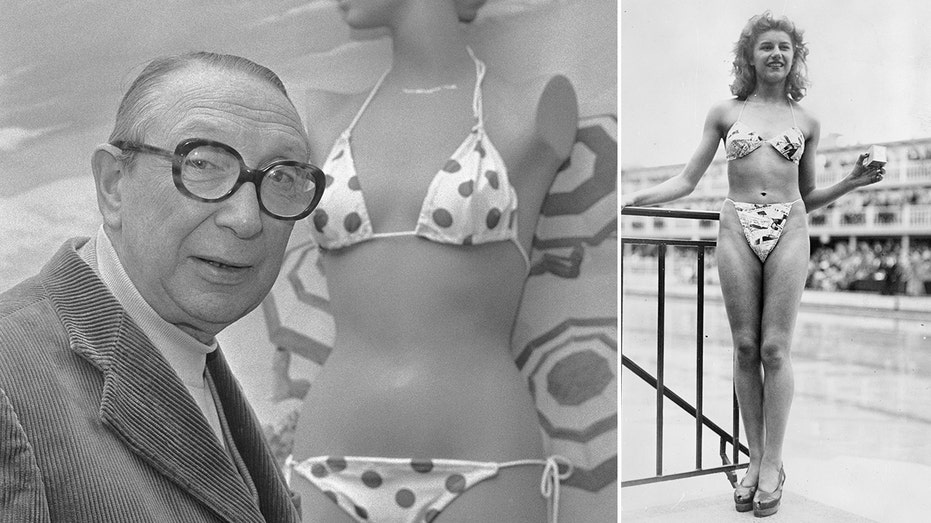
The modern bikini, though often adorned with a unique tie or charm, is nearly identical to the first official risqué two-piece set from the 1940s, which caused a stir for almost two decades due to its lack of modesty.
On July 5, 1946, 18-year-old Micheline Bernardini boldly wore the first black and white bikini of its kind during a press conference at a public swimming pool in Paris.
Louis Réard, a renowned French mathematician turned clothing designer, created the bikini design that women have been wearing for nearly 80 years with the intention of attracting attention. He hoped the bikini, featuring newspaper clippings, would cause as much shock and horror as the . The eye-catching photographs of Bernardini published on the front page of newspapers did just that.
Réard hired Bernardini to walk in front of cameras in his G-string bottom and triangle top design when professional runway models refused to wear the nearly-bare swimsuit.
Bernardini received around 50,000 fan letters, mostly from men, following the news coverage of the event, according to History.com
The design with little fabric was labeled “bikini” by Réard after the happened off the tiny island of earlier that week.
Although the admiration for Bernardini in 30 inches of cotton and jersey came quickly, Réard’s design struggled to gain popularity with American wearers until the 1960s. In the 1950s, European women began wearing the skimpy bikini, though Spain and Italy banned the suit style on public beaches in the early 1950s.
The scantiness of the bathing suit was partly due to material rationing during World War II.
on rationing of supplies across the U.S. and Britain, and restrictions on items including food, shoes and fabrics, among other supplies, were put in place to conserve.
To purchase rationed items, individuals had to both pay for food and materials, and also provide “points” at the time of purchase. Points were issued to people, including babies, in the form of blue and red stamps for a variety of selected items.
If an item was easily accessible but rationed, it cost fewer points than an item in high demand. In 1943, one pound of bacon cost 30 cents and 7 points, according to the National WWII Museum.
In terms of clothing, Britain rationed fabrics in 1941. A woman’s dress cost 11 points, and 8 points were required for a man’s shirt, according to the Imperial War Museum’s website.
The length of men’s shirts was restricted and double cuffs on collared shirts were banned altogether. Additionally, clothing prices rose and fabrics were limited. Some textiles, including silk, were made entirely unavailable to designers and manufacturers.
At the time, women’s fashion was not a priority, and the selection of clothing for women was scarce. As civilians remained dedicated to fashion, they made do with what was available and affordable.
As the British and American governments continued their efforts to conserve for their nations, designers like Réard adjusted their design and marketing strategies to appeal to audiences and used raw materials and resources like cotton to create stylized apparel that still met rationing requirements – hence the bikini.
When WWII ended, the rationing program did, too, but the bikini stuck around.
While Réard provided the name, bikini drama and an audience for Bernardini, his design was not the first two-piece swimsuit available to sunbathers, though it was the first to be cut below the navel.
In 1946, fashion designer Jacques Heim, and rival to Réard, revealed what he called the “smallest bathing suit in the world” and named it Atome for its size. However, his first designs were revealed in the 1930s.
Heim hoped to create the same level of excitement surrounding the itsy bitsy beach apparel as the explosion of an atomic bomb, according to the Museum of Jewish People.
Though women have appeared poolside in bikinis for nearly eight decades, the swimsuit remains a daring and attention-grabbing summer accessory.